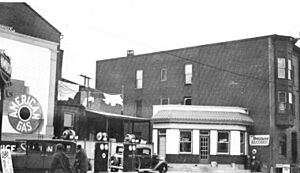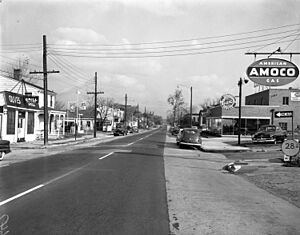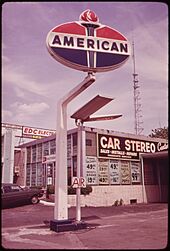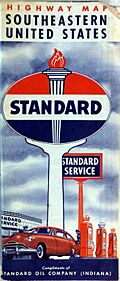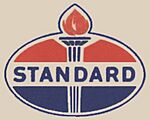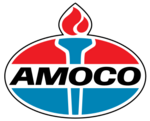Amoco facts for kids
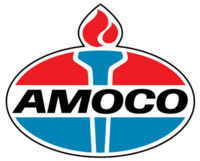 |
|
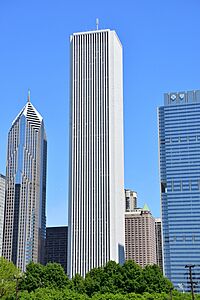
The Amoco Building (now the Aon Center) housed the Amoco headquarters in Chicago
|
|
|
Trade name
|
Amoco; Standard; and American |
|---|---|
|
Formerly
|
|
| Public | |
| Traded as | NYSE: AN (1985-1998) |
| Industry | Fuel |
| Fate | Merged with BP, becoming a brand, but resurfaced in 2017 selling BP fuel. |
| Predecessor | Standard Oil |
| Successor | BP Amoco |
| Founded | 1889, as part of the Standard Oil Trust |
| Founder | John D. Rockefeller |
| Defunct | December 31, 1998 |
| Headquarters | Amoco Building, |
Amoco is a well-known brand of gas stations in the United States. It is owned by a British company called BP. Amoco started as the Standard Oil Company of Indiana in 1889. It was founded by Standard Oil Company near an oil factory in Whiting, Indiana.
The company first focused on making gasoline for the new cars that were becoming popular. In 1911, it became its own independent company. Amoco's main office was in Chicago. The company officially changed its name to Amoco in 1985. In 1998, Amoco joined with BP. For a while, all Amoco stations became BP stations.
However, after a big oil spill in 2010, BP decided to bring the Amoco brand back. In 2017, Amoco gas stations started appearing again. This helped BP have more stations without having too many under just one name. This is similar to how other big oil companies like Chevron and ExxonMobil use different brand names.
In 1925, Standard Oil of Indiana bought the American Oil Company. This company was started in Baltimore in 1910 by Louis Blaustein and his son Jacob. The combined company used both the Standard and American or Amoco names for its gas stations. The Amoco name came from American oil company. By the mid-1900s, it was one of the biggest oil companies in the U.S.
Amoco helped create important parts of the modern fuel industry. They introduced the gasoline tanker truck and the drive-through gas station. They also sold "Amoco Super-Premium" lead-free gasoline many years before it became a rule to remove lead from gasoline. Amoco's main office was in the Amoco Building in Chicago, Illinois. This building is now called the Aon Center.
By 2023, there were over 600 new Amoco stations in the eastern and midwestern United States.
Amoco's History
Early Beginnings
Standard Oil (Indiana) was created in 1889 by John D. Rockefeller. It was part of the larger Standard Oil group. As more people started using cars, Indiana Standard decided to focus on selling gasoline. By 1911, the company sold most of the gasoline and kerosene in the Midwest. In 1912, they opened their first gas service station in Minneapolis, Minnesota.
When the Standard Oil group broke up in 1911, Indiana Standard was given the right to sell fuel in many Midwestern states. They could use the Standard name only in this area. Later, they bought other oil companies outside their main territory.
The American Oil Co. was started by the Blausteins in 1922. In 1923, they sold half of American Oil to another company. This deal helped Amoco get a steady supply of oil. Standard Oil of Indiana then bought that company in 1925. This is how John D. Rockefeller became connected to the Amoco name.
In the 1920s and 1930s, Indiana Standard built many new oil refining and drilling sites. They also created a new business called Stanolind in 1931 to find and produce oil. The company drilled over 1,000 oil wells in 1937 alone.
Moving Oil with Pipelines
In 1921, Indiana Standard bought half of the Sinclair Pipeline Company. This company owned many pipelines that carried crude oil in the Midwest. By 1931, all the pipeline companies were combined into the new Stanolind Pipeline Company. These pipelines were very important for moving oil across the country.
Selling Lead-Free Gasoline
In the 1920s, most oil companies started adding lead to gasoline. But American Oil chose to keep its premium "Amoco-Gas" (later "Amoco Super-Premium") lead-free. They used different chemicals to make the gasoline better, instead of lead. This was many years before people became worried about the environment and lead was removed from gasoline everywhere.
Helping During World War II
During World War II, Indiana Standard helped with the war effort. They found new ways to refine oil and even make TNT faster. They also provided a lot of gasoline for Allied airplanes and vehicles. During the war, Indiana Standard also created its chemical division.
After the War: Growth and Change
After World War II, Indiana Standard focused on improving oil refining in the U.S. In 1947, they were the first company to drill for oil offshore in the Gulf of Mexico. In 1948, their Stanolind Oil group invented Hydrafrac. This process helps get more oil out of wells and is used worldwide.
By 1952, Standard Oil of Indiana was the largest oil company in the U.S. It had 12 refineries and sold products in 41 states. It also owned thousands of miles of pipelines.
In 1956, gas stations in the southeastern U.S. that were called Pan-Am became Amoco stations. In 1961, Indiana Standard changed how it sold products. Its American Oil Company unit managed all retail operations. They used the Standard name in the Midwest and the American name outside that region. Both brands used the same torch and oval logo.
Soon after, the company started to grow internationally. By 1971, all parts of Indiana Standard used the Amoco name. Standard Oil Company (Indiana) officially became Amoco Corporation in 1985.
Making Chemicals
In the late 1950s and early 1960s, Indiana Standard made important scientific discoveries. They found PTA, a chemical used to make polyester fibers. In 1968, they bought other companies to form the Amoco Fabrics and Fibers Company.
Expanding Around the World
In the following years, Amoco grew globally. They opened plants, oil wells, or markets in over 30 countries. These included Italy, Australia, Britain, Belgium, Brazil, Argentina, Mexico, and many others. The company also bought parts of other oil companies, becoming one of the world's largest oil companies.
Joining with BP
On August 11, 1998, Amoco announced it would merge with British Petroleum (BP). This was one of the biggest company mergers ever. The original plan was to change all U.S. BP stations to Amoco and all overseas Amoco stations to BP. However, by 2004, BP decided to change all Amoco stations to BP stations instead. BP also used the Amoco names for its higher-grade gasolines, like Silver and Ultimate. By 2008, the "Amoco Fuels" name was mostly stopped.
After the Deepwater Horizon oil spill in 2010, some people thought BP might change its name back to Amoco in the U.S. Some independent BP stations, including former Amoco ones, even switched to different brands because of the public's reaction to the oil spill.
Amoco's Look and Feel
Company Logos
The first Indiana Standard logo was created in 1926. It was a circle with the words "Standard Oil Company (Indiana)" in red. It also had a torch with a flame, which stood for progress. This logo was seen on gas station buildings.
In 1932, American Oil introduced a logo that first used the name "Amoco". It was an oval with red top and bottom sections, and a black middle section with white letters. This logo was used in the northeastern U.S.
A new logo was made in 1946. It combined the Standard torch with the Amoco oval. The oval had red, white, and blue colors. This new logo was called the "Torch and Oval (T&O)". In places where the company couldn't use the "Standard" name, the logo said "Utoco" or "Pan-Am". When "Pan-Am" was replaced by "Amoco", it was the first time the torch and oval was used with the Amoco name.
In 1961, the torch and oval logo was updated. It had a flatter oval and a more modern torch design. It used the Standard or American name in the U.S. and the Amoco name outside the U.S.
The next logo update was in 1971. It had a blue bottom and a sleeker torch. The word "Standard" became italic and thicker. This was used by gas station owners who could choose between the Amoco name (more common in the East and South) or the Standard name (more common in the Midwest).
The final Amoco logo simply changed the name on the logo to "Amoco". It kept the familiar torch and divided oval. A horizontal logo was also used, with the italic "Amoco" word and red, white, and blue stripes. This was mostly seen on gas pumps and station signs.
After the merger with BP, the Amoco brand was kept for a while as a smaller part of the BP logo. The black background was changed to green to match BP's colors.
Even today, a few Amoco stations still use their old logo. The largest Amoco sign in the world is in St. Louis, Missouri. It is visible from far away. Most remaining Amoco stations are kept so BP can continue to own the Amoco and Standard trademarks.
In May 2008, U.S. BP stations mostly stopped using the "Amoco Fuels" logo. BP introduced its new fuel brand, "BP Gasoline with Invigorate". However, BP still uses the Silver and Amoco Ultimate names for its mid-grade and premium gasolines. For the 2017 return of the brand, the Amoco logo got a new, modern look.
Sports and Other Sponsorships
From 1968 to 1972, American Oil Company sponsored the American Freeway Patrol in San Diego. This patrol helped drivers who were stuck on the freeways and gave traffic reports on local radio.
In 1976, Amoco (using the "Standard" name) sponsored the Barney Oldfield Speedway ride at Marriott's Great America theme park in Gurnee, Illinois. Even though the sponsorship ended in 1985, the Standard logo can still be seen on the ride's cars.
In 1988, famous race car driver Mario Andretti drove the Amoco Ultimate Lola/Chevrolet car. He won races and helped promote Amoco. Andretti also appeared in Amoco TV commercials.
Dave Blaney drove a #93 car with Amoco sponsorship in NASCAR races from 1997 until the brand changed in 2001.
Important Events
On August 27, 1955, there was a large fire at the oil refinery in Whiting, Indiana. It caused a lot of damage and burned for eight days.
On March 16, 1978, a very large oil tanker called the Amoco Cadiz ran aground off the coast of France. This caused one of the biggest oil spills in history.
Amoco Brand Returns
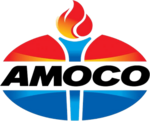 |
|
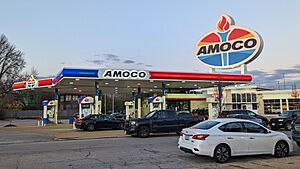
Amoco gas station in St. Louis, 2023
|
|
| Owner | BP |
|---|---|
| Introduced | 1998 |
| Markets | Eastern United States |
On October 10, 2017, BP announced that the Amoco name would return. BP wanted to gain more of the U.S. fuel market.
Many of the new Amoco stations were actually gas stations that used to be under different brands. This helped BP expand its reach. Other big oil companies like ExxonMobil (with Exxon & Mobil) and Chevron (with Chevron & Texaco) also use multiple brands.
In November 2017, several Gulf stations on Long Island, New York, were changed to Amoco stations. The Amoco brand also returned to the Pittsburgh area in fall 2020. A local company called Coen Markets made a deal with BP to sell Amoco-branded gasoline at all its locations.
Images for kids


